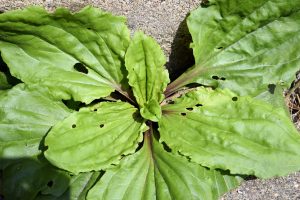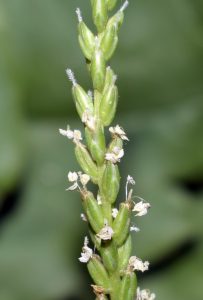Plantain, Rugel’s and Common
Two very similar plantain species may show up in our woodland areas. One is native and one is not. There are a few easy ways to tell them apart. The native species is Rugel’s plantain (Plantago rugelii), while the non-native version is known as common plantain (Plantago major). Both species will send up several flowering stems in succession once they get started June until frost.


Flowers of both species are very inconspicuous, and grow in a cluster up a long, narrow spike. Wind-pollination fertilizes the flowers resulting in the nutritious fruit capsules forming along the spike. Inside these capsules, the seeds of Rugel’s plantain are dark brown to black, while common plantain’s seeds are light brown. Easy ID: Rugel’s plantain has slender, rice-shaped seeds, while common’s is round; Rugel’s has dark purplish coloring at the base of the stems while common’s does not. Rugel’s 4-petaled, triangular shaped flowers are papery and whitish, while common plantain’s flowers are similar but tinted light brown.
The nutritious edibility by humans of both species is well-known, along with their healing qualities — one way to dispose of a plant that some consider weedy when it shows up in lawns! High in calcium and vitamins A, C, and K, the young, tender leaves of both species can be eaten raw, while the older, stringier leaves can be boiled in stews. The seeds are also edible, and birds love them for their oil; they are often included in bird seed mixes. For humans, however, consuming large quantities of the seeds can lead to a drop in blood pressure, so don’t do that!
Plantain has other assets, depending on how you look at it. As a strong, low-growing and therefore persistent plant, plantain lends it self very well to erosion control, and can also reach its roots down to break up hard-packed soil.
Fun Fact
- Plantain is not related to the banana type of fruit which is also called plantain.
- Leaves grow close to the ground in a basal rosette (which makes them hard to mow).
